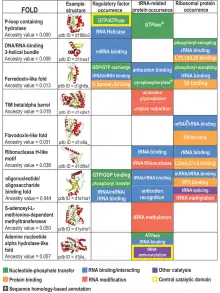Protein fold class
Protein fold classes are broad categories of protein tertiary structure topology. They describe groups of proteins that share similar amino acid and secondary structure proportions. Each class contains multiple, independent protein superfamilies (i.e. are not necessarily evolutionarily related to one another).[1][2][3]

Generally recognised classes
Four large classes of protein that are generally agreed upon by the two main structure classification databases (SCOP and CATH).
all-α
All-α proteins are a class of structural domains in which the secondary structure is composed entirely of α-helices, with the possible exception of a few isolated β-sheets on the periphery.
Common examples include the bromodomain, the globin fold and the homeodomain fold.
all-β
All-β proteins are a class of structural domains in which the secondary structure is composed entirely of β-sheets, with the possible exception of a few isolated α-helices on the periphery.
Common examples include the SH3 domain, the beta-propeller domain, the immunoglobulin fold and B3 DNA binding domain.
α+β
α+β proteins are a class of structural domains in which the secondary structure is composed of α-helices and β-strands that occur separately along the backbone. The β-strands are therefore mostly antiparallel.[4]
Common examples include the ferredoxin fold, ribonuclease A, and the SH2 domain.
α/β
α/β proteins are a class of structural domains in which the secondary structure is composed of alternating α-helices and β-strands along the backbone. The β-strands are therefore mostly parallel.[4]
Common examples include the flavodoxin fold, the TIM barrel and leucine-rich-repeat (LRR) proteins such as ribonuclease inhibitor.
Additional classes
Membrane proteins
Membrane proteins interact with biological membranes either by inserting into it, or being tethered via a covalently attached lipid. They are one of the common types of protein along with soluble globular proteins, fibrous proteins, and disordered proteins.[5] They are targets of over 50% of all modern medicinal drugs.[6] It is estimated that 20–30% of all genes in most genomes encode membrane proteins.[7]
Intrinsically disordered proteins
Intrinsically disordered proteins lack a fixed or ordered three-dimensional structure.[8][9][10] IDPs cover a spectrum of states from fully unstructured to partially structured and include random coils, (pre-)molten globules, and large multi-domain proteins connected by flexible linkers. They constitute one of the main types of protein (alongside globular, fibrous and membrane proteins).[5]
Coiled coil proteins
Coiled coil proteins form long, insoluble fibers involved in the extracellular matrix. There are many scleroprotein superfamilies including keratin, collagen, elastin, and fibroin. The roles of such proteins include protection and support, forming connective tissue, tendons, bone matrices, and muscle fiber.
Small proteins
Small proteins typically have a tertiary structure that is maintained by disulphide bridges (cysteine-rich proteins), metal ligands (metal-binding proteins), and or cofactors such as heme.
Designed proteins
Numerous protein structures are the result of rational design and do not exist in nature. Proteins can be designed from scratch (de novo design) or by making calculated variations on a known protein structure and its sequence (known as protein redesign). Rational protein design approaches make protein-sequence predictions that will fold to specific structures. These predicted sequences can then be validated experimentally through methods such as peptide synthesis, site-directed mutagenesis, or Artificial gene synthesis.
See also
- Protein superfamily
- SCOP database
- CATH database
- FSSP database
References
- Hubbard, Tim J. P.; Murzin, Alexey G.; Brenner, Steven E.; Chothia, Cyrus (1997-01-01). "SCOP: a Structural Classification of Proteins database". Nucleic Acids Research. 25 (1): 236–239. doi:10.1093/nar/25.1.236. ISSN 0305-1048. PMC 146380. PMID 9016544.
- Greene, Lesley H.; Lewis, Tony E.; Addou, Sarah; Cuff, Alison; Dallman, Tim; Dibley, Mark; Redfern, Oliver; Pearl, Frances; Nambudiry, Rekha (2007-01-01). "The CATH domain structure database: new protocols and classification levels give a more comprehensive resource for exploring evolution". Nucleic Acids Research. 35 (suppl 1): D291–D297. doi:10.1093/nar/gkl959. ISSN 0305-1048. PMC 1751535. PMID 17135200.
- Fox, Naomi K.; Brenner, Steven E.; Chandonia, John-Marc (2014-01-01). "SCOPe: Structural Classification of Proteins—extended, integrating SCOP and ASTRAL data and classification of new structures". Nucleic Acids Research. 42 (D1): D304–D309. doi:10.1093/nar/gkt1240. ISSN 0305-1048. PMC 3965108. PMID 24304899.
- Efimov, Alexander V. (1995). "Structural Similarity between Two-layer α/β and β-Proteins". Journal of Molecular Biology. 245 (4): 402–415. doi:10.1006/jmbi.1994.0033. PMID 7837272.
- Andreeva, A (2014). "SCOP2 prototype: a new approach to protein structure mining". Nucleic Acids Res. 42 (Database issue): D310–4. doi:10.1093/nar/gkt1242. PMC 3964979. PMID 24293656.
- Overington JP, Al-Lazikani B, Hopkins AL (December 2006). "How many drug targets are there?". Nat Rev Drug Discov. 5 (12): 993–6. doi:10.1038/nrd2199. PMID 17139284.
- Krogh, A.; Larsson, B. R.; Von Heijne, G.; Sonnhammer, E. L. L. (2001). "Predicting transmembrane protein topology with a hidden markov model: Application to complete genomes". Journal of Molecular Biology. 305 (3): 567–580. doi:10.1006/jmbi.2000.4315. PMID 11152613.
- Dunker, A. K.; Lawson, J. D.; Brown, C. J.; Williams, R. M.; Romero, P; Oh, J. S.; Oldfield, C. J.; Campen, A. M.; Ratliff, C. M.; Hipps, K. W.; Ausio, J; Nissen, M. S.; Reeves, R; Kang, C; Kissinger, C. R.; Bailey, R. W.; Griswold, M. D.; Chiu, W; Garner, E. C.; Obradovic, Z (2001). "Intrinsically disordered protein". Journal of Molecular Graphics & Modelling. 19 (1): 26–59. CiteSeerX 10.1.1.113.556. doi:10.1016/s1093-3263(00)00138-8. PMID 11381529.
- Dyson HJ, Wright PE (March 2005). "Intrinsically unstructured proteins and their functions". Nat. Rev. Mol. Cell Biol. 6 (3): 197–208. doi:10.1038/nrm1589. PMID 15738986.
- Dunker AK, Silman I, Uversky VN, Sussman JL (December 2008). "Function and structure of inherently disordered proteins". Curr. Opin. Struct. Biol. 18 (6): 756–64. doi:10.1016/j.sbi.2008.10.002. PMID 18952168.